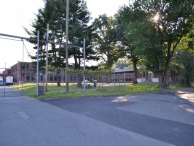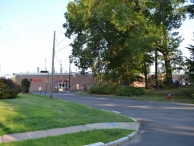Mill Record West Hartford
RETURN TO ‘FIND MILLS’Disclaimer: Content for these properties was compiled in 2014-2017 from a variety of sources and is subject to change. Updates are occasionally made under Property Information, however the Connecticut Trust for Historic Preservation (dba Preservation Connecticut) makes no representation or warranty that the information is complete or up-to-date.
- Complex Name (Common)
- Wiremold Co.
- Complex Name (Historic)
-
- Wiremold Co.
- Address or Location
- 60 Woodlawn Street, Elmwood, West Hartford
- County
- Hartford
- Historic Designation
- Associated Mill Community
- n/a
 What can you do at this mill?
What can you do at this mill?
- Historic Information
Companies Associated w/Complex
- Wiremold Co. 1929-Present (2015)
Use (Historic)
Largest Documented Workforce
595 (1992).
Historic Narrative
The firm that would eventually become the Wiremold Company was founded by D. Hayes Murphy, the son of an Irish immigrant and a native of Milwaukee, Wisconsin. After graduating from college in 1900, Murphy became interested in the Richmondt Electric Wire Company, a fledgling firm that had developed a rigid conduit used for household wiring. Murphy quickly identified both the potential of the product and the shortfalls in the company’s management, and moved to acquire the Richmondt Electric Wire Company for $10,000 in 1900. In 1901, he relocated the firm from Milwaukee to Waukegan, Illinois, and changed its name to the American Interior Conduit Company. Less than a year later, however, tough competition in the electrical products industry forced Murphy to merge his firm with the Safety Armorite Conduit Company, the largest producer of electrical conduit in the country at the time. Murphy remained associated with American Interior Conduit until 1911, whereupon he convinced the ownership at Safety Armorite to trade his stock in the conglomerate for one of its recent acquisitions, the American Conduit Manufacturing Company of New Kensington, Pennsylvania. American Conduit manufactured lines of both rigid and fabric electrical conduit and listed the American Locomotive and Pullman Companies among its primary clients. Murphy quickly moved to expand the firm’s capacity by erecting a new factory and initiating a profit-sharing program in order to motivate employees. One of the most promising technologies developed by American Conduit in this period was its Wiremold raceway system, a surface-mounted metal conduit unveiled in 1916 that could be used to retrofit houses with nonexistent or inadequate wiring systems. The product presented incredible promise, however, a variety of issues ranging from material shortages resultant of the First World War to production backlogs in the firm’s other divisions, presented Murphy with a host of financial problems. In an effort to focus on Wiremold, Murphy sold off the rigid conduit section of the business and moved the remainder of the firm to the former Franklin Lamp Works plant in Hartford, Connecticut, in 1919. Challenges remained for American Conduit, however, Murphy was so confident of the potential of his product that he renamed the firm to the American Wiremold Company in 1920. The company finally turned its first profit in 1923, and in 1926 it was reorganized as the Wiremold Company. Further increases in business necessitated the construction of a new plant in 1929, erected in West Hartford, Connecticut, on the eve of the Great Depression. Wiremold weathered this financial calamity without terminating any employees and by the mid-1930s was again moving forward with plant improvements. A new manufacturing building and office were erected in 1935, and an additional factory block was completed in 1937. Murphy resigned as head of the company in 1955 after his son, John Murphy, stepped into the role. The Wiremold Company continued to grow and diversify through the 1950s and 1960s and it was not until 1979 that an individual not related to the Murphy family held the position of president and CEO. During the early 1990s, after slipping into a stagnant state, the company gained significant notoriety after its CEO, Art Byrne, reorganized the firm under the ‘kaizen’ system of lean management, a practice developed by Toyota. The approach revitalized the company and gained the attention of French electrical manufacturer Legrand SA, which acquired Wiremold for $770 million in 2000. Legrand’s control of the company has been marked by mixed returns and significant layoffs, however, production presently continues at the West Hartford plant.
- Architectural Information
Number of Existing Buildings
Roughly seven (7) adjoining primary blocks.
Dates of Construction
1929, 1935, 1937, 1948, 1965, 1967, 1986.
Architect
n/a
Builder
n/a
Building Type
Architectural Description
The Wiremold Company plant is comprised of roughly seven adjoining primary blocks located at the eastern terminus of Page Avenue and Prescott Street, Southern terminus of Railroad Place, and along the west side of the rail line running between New Haven and Hartford, Connecticut. The oldest section of the plant consists of the northernmost of the four manufacturing blocks, which is a two-story, 90’ x 234’ red brick building erected in 1929. The block is of brick pier construction and has tall window openings with replacement sash, brick sills, and corbelled headers on the second story. Tile coping caps a brick parapet and the roof is flat. The plant was enlarged in 1935 through the construction of a one-story, 57’ x 67’ red brick office building, and the first half of a two-story, 88’ x 234’ red brick manufacturing block, which was completed in 1937. The office has a raised concrete basement level, rectangular window openings with concrete sills, a concrete cornice, red brick parapet with tile coping, and a flat roof. The primary entrance is on its east elevation, this consisting of a pored concrete stair leading to a pedimented portico with Tuscan columns. The manufacturing block is identical in detail to the 1929 factory and is connected to it by a two-story ell. The next addition to the plant was completed in 1948 when a one-and-a-half-story, 120’ x 246’ steel-frame manufacturing block was erected roughly 50’ south of the 1937 building. This has a mix of red brick and corrugated metal apron walls and a clerestory monitor roof. It is attached to its northern neighbor by a one-story ell. A fourth manufacturing block, this erected in 1986 and measuring 361’ x 317’, stands roughly 85’ to the south and is connected to the 1948 block in a similar manner. This fourth manufacturing building is of steel frame construction and has red brick apron walls and a flat roof. The final building of note associated with the plant is a two-story, 76’ x 86’ office annex erected between the office and 1929 manufacturing block in 1967. This is of steel-frame construction with brick apron walls, large ribbon windows with metal sash, and a flat roof.
Exterior Material(s)
Structural System(s)
Roof Form
Roof Material
Power Source
Condition
Good
Condition Notes
The complex is in good condition. The buildings all appear to be well maintained, however, all of the windows appear to have been replaced with modern units.
- Property Information
-
Specific Location
One legal parcel (60 Woodlawn Street) totaling 13.15 acres located at the eastern terminus of Page Avenue and Prescott Street, Southern terminus of Railroad Place, and along the west side of the rail line running between New Haven and Hartford, Connecticut.
Adjacent To
Exterior Visible from Public Road?
Yes
Parcel ID / Assessor Record Link
- G15/6291/60. / Link →
Acreage
13.15
Use (Present)
- Sources
-
Form Completed By
Lucas A. Karmazinas
Date
08/17/2015
Bibliography
- List of Connecticut Manufacturers, 1922, 1924, 1930, 1932.
- Directory of Connecticut State Manufacturers, 1936, 1939.
- Industrial Directory of Connecticut, 1947.
- Register of War Production Facilities in Connecticut, 1951.
- Atlas of Hartford City and West Hartford Town, Connecticut; L.J. Richards & Co., 1896.
- Atlas of Hartford City and West Hartford Town, Connecticut; L.J. Richards & Co., 1909.
- Sanborn Map Company, 1917, 1923, 1950.
- Aerial Survey of Connecticut, 1934, 1965.
- Hartford City Directory, Various editions.
- The Wiremold Company: A Century of Solutions; Smith, Jim H., 2000.
- Representative View(s)Click on image to view full file








